Related Research Articles

The Osci were an Italic people of Campania and Latium adiectum before and during Roman times. They spoke the Oscan language, also spoken by the Samnites of Southern Italy. Although the language of the Samnites was called Oscan, the Samnites were never referred to as Osci, nor were the Osci called Samnites.
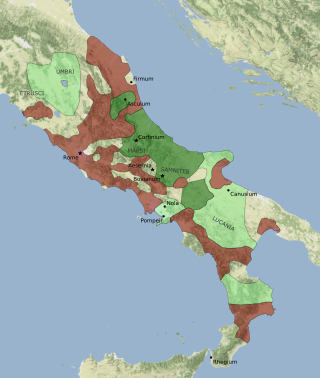
The Social War, also called the Italian War or the Marsic War, was fought largely from 91 to 87 BC between the Roman Republic and several of its autonomous allies in Italy. Some of the allies held out until 87 BC.
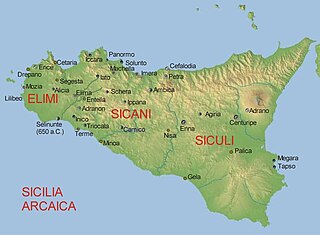
Éntella, was an ancient city in the interior of Sicily, situated on the left bank of the river Hypsas, and nearly midway between the two seas, being about 40 km from the mouth of the Hypsas, and much about the same distance from the north coast of the island, at the Gulf of Castellamare.

Osona is a comarca situated in the central region of Catalonia, Spain. Its capital is Vic. Its population in 2001 was 129,543. Osona covers roughly the same area as the historic Catalan county of Osona. The name Osona comes from Ausetans, a group of Iberian people who had their capital in Ausa ; the Romans called the area Ausone or Ausona. While most of the comarca is within the province of Barcelona, the municipalities of Espinelves, Vidrà and Viladrau form part of the province of Girona.
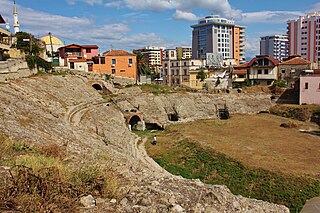
The city of Epidamnos later the Roman Dyrrachium, was founded in 627 BC in Illyria by Greek colonists from Corinth and Corcyra. Aristotle's Politics several times draws for examples on the internal government of Epidamnos, which was run as a tight oligarchy that appointed a ruling magistrate; tradesmen and craftsmen were excluded from power, until internal strife produced a more democratic government. The exiled oligarchs appealed to Corcyra while the democrats enlisted the help of Corinth, initiating a struggle between the two mother cities described by Thucydides as a cause of the Peloponnesian War. Individual trading with the local Illyrians was forbidden at Epidamnos: all traffic was through the authorized city agent or poletes. In the fourth century BC the city-state was part of the kingdoms of Cassander and Pyrrhus. The general vicinity of Epidamnos was called Epidamnia.

The Liri is one of the principal rivers of central Italy, flowing into the Tyrrhenian Sea a little below Minturno under the name Garigliano.
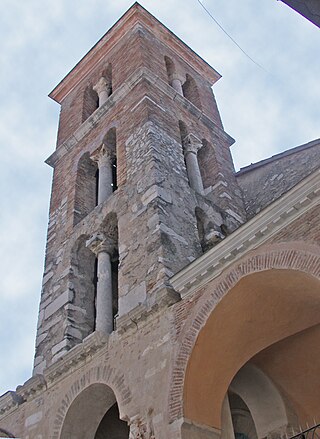
Minturno is a city and comune in southern Lazio, Italy, situated on the north west bank of the Garigliano.
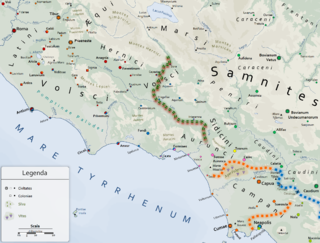
The Aurunci were an Italic tribe that lived in southern Italy from around the 1st millennium BC. They were eventually defeated by Rome and subsumed into the Roman Republic during the second half of the 4th century BC.

Corfinium was an ancient city now near modern Corfinio, in the province of L'Aquila.

Avella is a town and comune in the province of Avellino, Campania, southern Italy. It is renowned for the cultivation of hazelnuts, whose specific name (Corylus avellana) derives precisely from this territory.

Alsium was an ancient city on the coast of Etruria, between Pyrgi and Fregenae, on the Via Aurelia, by which it is about 35 km from Rome near the modern Ladispoli. It was one of the oldest towns of Etruria, but does not appear in history until the Roman colonisation of 247 BC. It was never of great importance, except as a resort of wealthy Romans, many of whom had villas there.
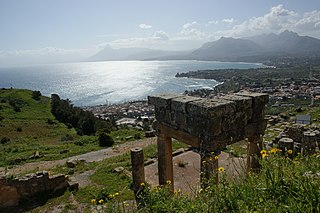
Soluntum or Solus was an ancient city on the Tyrrhenian coast of Sicily near present-day in the comune of Santa Flavia, Italy. The site is a major tourist attraction. The city was founded by the Phoenicians in the sixth century BC and was one of the three chief Phoenician settlements in Sicily in the archaic and classical periods. It was destroyed at the beginning of the fourth century BC and re-founded on its present site atop Monte Catalfano. At the end of the fourth century BC, Greek soldiers were settled there and in the 3rd century BC the city came under the control of the Roman Republic. Excavations took place in the 19th century and in the mid-20th century. Around half of the urban area has been uncovered and it is relatively well preserved. The remains provide a good example of an ancient city in which Greek, Roman and Punic traditions mixed.
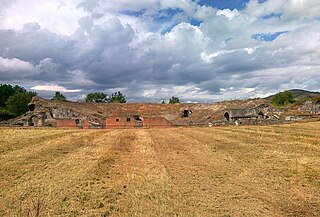
Cales was an ancient city of Campania, in today's comune of Calvi Risorta in southern Italy, belonging originally to the Aurunci/Ausoni, on the Via Latina.

"Ausones", the original name and the extant Greek form for the Latin "Aurunci", was a name applied by Greek writers to describe various Italic peoples inhabiting the southern and central regions of Italy. The term was used, specifically, to denote the particular tribe which Livy called the Aurunci, but later it was applied to all Italians, and Ausonia became a poetic term, in Greek and Latin, for Italy itself.

Ausonia is a town and comune in southern Lazio, central Italy. It takes its name from the Ausones/Aurunci, whose ancient town Ausona, located nearby, was destroyed by the Romans in 314 BC. In the Middle Ages it was known as Fratte.

Laurentum was an ancient Roman city of Latium situated between Ostia and Lavinium, on the west coast of the Italian Peninsula southwest of Rome. Roman writers regarded it as the original capital of Italy, before Lavinium assumed that role after the death of King Latinus. In historical times, Laurentum was united with Lavinium, and the name Lauro-Lavinium is sometimes used to refer to both.

Helorus, Heloros, Helorum, or Elorus, was an ancient Greek city of Magna Graecia in Sicily, situated near the east coast, about 40 km south of Syracuse and on the banks of the river of the same name. It is currently an archaeological site in the modern comune of Noto.

Apollonia was an ancient city of Magna Graecia in Sicily, which, according to Stephanus of Byzantium, was situated in the neighbourhood of Aluntium and Calacte.
Sinuessa was a city of Latium, in the more extended sense of the name, situated on the Tyrrhenian Sea, about 10 km north of the mouth of the Volturno River. It was on the line of the Via Appia, and was the last place where that great highroad touched on the sea-coast. The ruins of the city are located in the modern-day comune of Sessa Aurunca. The city ruins are located, as the crow flies, 12.24 km SSW from the modern city of Sessa Aurunca and 41.43 km from the Province of Caserta. It is 26.71 km from the regional capital (Naples/Napoli) Campania, Italy.
The ancient city of Aurunca was the capital or metropolis of the little mountain tribe of the Aurunci, was situated on one of the summits of the volcanic group of mountains, which rise above the plains of Campania, near Suessa and Teanum.
References
 This article incorporates text from a publication now in the public domain : Bunbury, Edward Hurbert (1854). "Ausona". In Smith, William (ed.). Dictionary of Greek and Roman Geography . Vol. I. London: John Murray. p. 345.
This article incorporates text from a publication now in the public domain : Bunbury, Edward Hurbert (1854). "Ausona". In Smith, William (ed.). Dictionary of Greek and Roman Geography . Vol. I. London: John Murray. p. 345.


